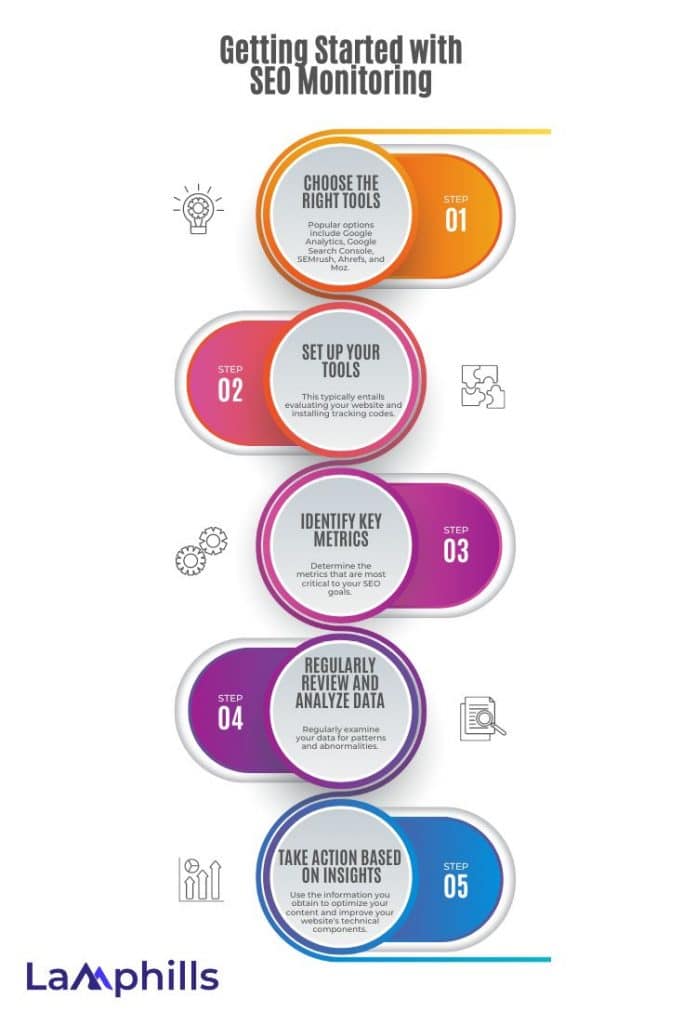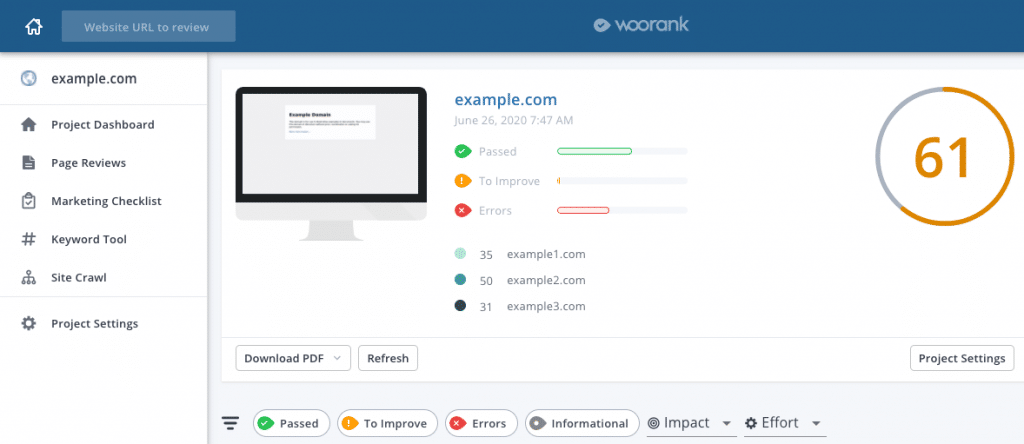I recall when I first created a website. I was ecstatic, and confident that visitors would rush to my pages and that my material would easily get to the top of search results. But as the days passed into weeks, the traffic I had hoped for did not materialize. That’s when I realized the value of SEO monitoring. Understanding how search engines perceive and rank your site is critical, and in this article, I’ll explain why SEO monitoring is so important for beginners and how to get started. This procedure completely revolutionized my approach, and it can do the same for you.
What is SEO Monitoring?
SEO monitoring is tracking a variety of variables to determine your website’s success in search engine results. It’s more than just tracking your rankings; it’s also about learning about the health of your website, the behavior of your target audience, and the efficacy of your SEO strategies. This complete method assists you in determining what is and is not working, as well as what changes you should make.
But that is not all. The SEO monitoring procedure involves:
- Monitoring your keyword ranks on search engine results pages (SERPs) over time.
- Analyzing the profiles of backlinks that point to your site
- Monitoring engagement data, such as page visits, bounce rate, and click-through rate (CTR).
- Check for broken links to prevent penalties from search engines.
- Monitor technological elements such as page speed.
- Identifying trouble areas, such as crawling issues and slow page speeds
- Regular checkups keep you up to date on how your website is doing. So you know which modifications to make.
Later, we’ll get into how to do SEO monitoring using the correct tools and KPIs. But first, let’s talk about why SEO monitoring is so important.
Read Also: SEO Reputation Management: How I Protect & Enhance My Online Presence
Key Takeaways
- SEO monitoring helps improve visibility and traffic by tracking keyword rankings and identifying opportunities for optimization, ensuring your content ranks higher in search results.
- It identifies and fixes issues such as broken links, slow load times, and crawl errors, maintaining a technically sound website that provides a smooth user experience.
- SEO monitoring tools provide insights into user behavior, allowing you to fine-tune your content strategy to increase engagement and improve dwell time, which positively impacts search engine rankings.
- By measuring the effectiveness of your SEO strategies through tools like Google Analytics and SEMrush, you can calculate the ROI of your efforts and adjust your approach based on data-driven insights.
- Regularly monitoring your SEO performance helps you stay ahead of competitors by spotting new opportunities and trends, allowing you to adapt and refine your strategies for better results.
Why SEO Monitoring is Important
#1. Improves visibility and traffic
SEO monitoring helps keep your website visible in search engine results. Tracking your keyword rankings allows you to understand which terms drive traffic and which ones require additional attention. According to statistics, the top three organic search results account for more than 75% of all clicks. If you are not monitoring your SEO, you are missing out on opportunities to optimize your content and rank higher in search results.
#2. Identify and fix issues
A well-optimized site is about more than just keywords. It’s also important to have a technically competent website. SEO monitoring tools can notify you of issues such as broken links, poor load times, and crawl errors that may be impeding your site’s performance. Quickly resolving these issues contributes to a smooth user experience and keeps search engines pleased.
#3. Understand User Behavior
SEO monitoring tools frequently incorporate analytics features that provide information about how users interact with your website. You can observe which pages are the most popular, how long visitors remain, and where they leave off. This data is invaluable for fine-tuning your content strategy and increasing user engagement. For example, a longer dwell time on sites can indicate to search engines that your information is worthwhile, thereby increasing your ranks.
#4. Measure the effectiveness of your SEO strategies
Without monitoring, you’ll never know if your SEO efforts are effective. Are your backlinks from reputable websites improving your rankings? Is your content connecting with your target audience? Tools such as Google Analytics and SEMrush can generate extensive information on your SEO success, allowing you to calculate the ROI of your strategy.
#5. Stay ahead of competitors
In the highly competitive world of SEO, standing still means falling behind. Monitoring your SEO performance enables you to stay ahead of the competition by spotting new opportunities and trends. You may monitor your opponents’ ranks and strategies, allowing you to adjust and improve your approach. For example, if a competitor’s blog post outranks yours, you can examine their content and better your own.
Getting Started with SEO Monitoring

Step #1. Choose the Right Tools
The first step in SEO monitoring is to select the appropriate tools. Popular options include Google Analytics, Google Search Console, SEMrush, Ahrefs, and Moz. Each of these tools has unique features, so select the ones that best meet your requirements.
When I originally began, I depended heavily on Google Analytics and Search Console. They offered a variety of information on my website’s performance and were quite helpful in finding areas for development. As my understanding improved, I started using tools like SEMrush to gain more granular insights into my keyword ranks and backlink profile.
Step #2. Set Up Your Tools
After you’ve picked your tools, the next step is to set them up. This typically entails evaluating your website and installing tracking codes. Each tool will have its own setup process, but there are numerous tutorials available to walk you through it.
Detailed Steps to Set Up Key SEO Tools:
- Google Analytics:
- Register for a Google Analytics account at analytics.google.com.
- Set up a Property: Add your website as a new property to your Google Analytics account. This includes inputting your website’s name, URL, and industry category.
- Get Tracking Code: Google Analytics will generate a tracking code (a JavaScript snippet) for you.
- Add the tracking code to the element of each page on your website. If you’re using a content management system (CMS) like WordPress, you can streamline this procedure with plugins like Google Site Kit or Insert Headers and Footers.
- Verify Setup: Check the Real-Time report in Google Analytics to ensure that your tracking code is operating properly. If everything is set up correctly, your own visit should display.
- Google Search Console:
- Add a Property: Navigate to search.google.com/search-console and register your website as a new property.
- Verify Ownership: Select a verification technique, such as HTML file upload, HTML tag, Google Analytics, or DNS record. Follow Google’s instructions. If you select HTML, you’ll need to include a certain meta tag in your website’s section.
- Publish Sitemap: Once validated, publish your website’s sitemap using the Search Console dashboard. This helps Google comprehend your website’s structure and index it more effectively.
- Monitor Performance: Use the Search Console dashboard to track your site’s search performance, index coverage, and detect problems. Check for crawl faults and security vulnerabilities regularly.
- SEMrush:
- Create an account at semrush.com.
- Create a new project for your website in SEMrush.
- Conduct a site audit to uncover technical SEO concerns such as broken links, slow-loading pages, and poor mobile usability.
- Position Tracking: Enable position tracking to track your keyword ranks over time. Enter your desired keywords, and SEMrush will monitor how they perform in search engine results.
- Backlink Audit: Utilize the backlink audit tool to examine your backlink profile. Identify any hazardous backlinks and, if necessary, disavow them.
- Integrations: Combine SEMrush with Google Analytics and Google Search Console to gain more detailed data and insights.
- Ahrefs:
- Create an account at ahrefs.com.
- Add Your Website: Connect your website to the Ahrefs dashboard to begin measuring its performance.
- Conduct a site audit to identify SEO concerns such as broken links, duplicate content, and slow page load times.
- Rank Tracker: Enable rank monitoring to track the success of your desired keywords. Ahrefs will provide extensive reports on keyword rankings and changes over time.
- Backlink Checker: Use the backlink checker to track your backlink profile. Identify high-quality backlinks and look for ways to get more.
- Use the content explorer to discover the best-performing content in your niche. This might help you generate fresh content ideas and identify what types of content your audience prefers.
- Moz:
- Create an account on moz.com.
- Add Your Website: Connect your site to the Moz dashboard to begin tracking its SEO performance.
- Crawl Your Website: Use Moz’s site crawl feature to detect SEO issues like broken links, missing title tags, and duplicate content.
- Track Rankings: Enable rank tracking to monitor the performance of your desired keywords. Moz offers thorough reports on keyword rankings and changes over time.
- Analyze Backlinks: Use the link explorer to examine your backlink profile. Identify high-quality backlinks and look for ways to get more.
- Use the Keyword Explorer to discover new keywords to target. This tool lets you understand the search volume, keyword difficulty, and potential traffic for certain keywords.
By completing these steps, you’ll have a good basis for monitoring and enhancing your website’s SEO performance.
#3. Identify key metrics
Determine the metrics that are most critical to your SEO goals. By focusing on these variables, you can gain a better understanding of your SEO performance.
These metrics may include:
- Keyword Rankings: Monitor how your website ranks in search engine results for specific keywords.
- Organic Traffic: Keep track of the quantity of visitors who come to your site from unpaid search results.
- Bounce Rate: Determine the percentage of visitors who depart your website after reading only one page.
- Click-Through Rate (CTR): Determine the percentage of users who click on your website’s link in the SERPs.
- Conversion Rate: Calculate the percentage of visitors who perform a desired activity, such as placing a purchase or submitting a contact form.
Using a personalized SEO monitoring template might help to simplify this procedure. It helps you to track your critical indicators all in one location, making it easier to see patterns and make data-driven decisions. You can download our free SEO Monitoring Template below.
#4. Regularly review and analyze data
SEO monitoring is not a one-time effort; it is a continuous process. Regularly examine your data for patterns and abnormalities. Based on the information you gathered, look for ways to improve your content, resolve technical difficulties, and alter your SEO efforts accordingly.
- Schedule regular reviews
- For most sites, the frequency is weekly or monthly, whereas high-traffic sites are updated daily.
- Tools include Google Analytics, Google Search Console, SEMrush, Ahrefs, and Moz.
- Identify trends and anomalies
- Trends: Look for persistent trends and seasonal variations.
- Anomalies: Look for rapid changes that could suggest problems.
- Analyze key metrics
- Keyword Performance: Monitor keyword ranks.
- Organic Traffic: Keep track of changes in organic traffic.
- Bounce Rate: Improve pages with high bounce rates.
- CTR: Make sure the meta titles and descriptions are appealing.
- Conversion Rate: Improve underperforming pages.
- Look for opportunities
- Content Enhancement: Update and optimize content.
- Technical fixes include issues such as broken links and crawl failures.
- Competitive Analysis: Analyze competitors to identify opportunities.
- Adjust your SEO strategies
- Data-Driven Decisions: Modify strategy based on data.
- Test and Optimize: Make adjustments and optimize.
- Continuous Learning: Stay current with SEO developments.
- Report and communicate findings.
- Documentation: Keep track of findings and revisions.
- Communication: Share findings with your colleagues.
Regularly evaluating and analyzing your SEO data allows you to consistently enhance your site’s performance and stay ahead of the competition.
Step #5. Take Action Based On Insights
The ultimate purpose of SEO monitoring is to help you develop your strategy and actions. Use the information you obtain to optimize your content, create high-quality backlinks, and improve your website’s technical components. Remember that SEO is an iterative process—the more you tweak and adjust, the better your results will be.
Here is a summary of how to successfully use insights:
- Optimize your content
- Improve readability, include relevant keywords, and keep the text up to date. Identify gaps and write content around high-potential keywords. Improve on-page SEO by optimizing meta titles, descriptions, headers, and picture alt texts.
- Create high-quality backlinks
- Contact websites that connect to rivals and have high-quality content. Guest posting on respected websites can help you develop backlinks and boost your visibility. Check your backlink profile regularly and remove any detrimental links.
- Improve technical SEO
- Address broken links, crawl failures, and mobile usability. To enhance loading time, optimize images, and minimize JavaScript. Make your website responsive to all devices. To improve crawlability, ensure that the structure is clear and logical.
- Enhance User Experience (UX)
- Use clear labels to make it easier to navigate the site. Use high-quality photos and videos. Add interactive elements such as quizzes, polls, and comment sections to engage users.
- Monitor and adjust
- Keep track of metrics and find opportunities for improvement. Iterate Based on Results: Modify strategies based on performance data. Keep up with SEO trends and algorithm updates.
- Report progress
- Keep track of changes and their outcomes. Use visuals to communicate results and progress with your team.
Taking these measures based on SEO monitoring allows you to continuously adjust and improve the performance of your website, ensuring that your strategies remain successful and competitive.
The Best SEO Monitoring Tools for Your Business In 2024
There are various tools available to assist you in keeping track of how your website and content are working.
These tools can aid with keyword research, content marketing, rank tracking, link building, and technical SEO.
#1. ContentKing

ContentKing is a real-time monitoring tool that may provide you with insights and activities to improve your SEO.
This tool allows you to devise current trends and identify places for improvement. It also provides regular SEO auditing to keep you up to date without extra effort.
Additional capabilities include the ability to trace all your modifications and establish a search history.
#2. Seolyzer

Seolyzer is a free, simple SEO monitoring tool that aims to determine how search engines such as Google see your website.
It uses real-time data to monitor page speed and performance, redirections, and other aspects of your website.
All of these can have an impact on your rankings, so being aware of and rectifying them can help you gain visitors.
#3. Seomater

Seomater crawls your website and provides you with detailed SEO audit results in the form of a report.
These assessments concentrate on content quality, backlinks, social media, website speed, HTML tags, organic presence, and a few other factors.
Along with the performance study, you will receive recommendations on how to address the identified issues, such as site structure or content.
Seomater also connects seamlessly with other tools you may use, such as Google Analytics, Slack, Salesforce, WordPress, or MailChimp.
#4. Oncrawl

Oncrawl is an enterprise-level SEO monitoring tool built primarily for larger, more complicated websites.
You can select between two product suites.
The Oncrawl Insights product package focuses on prescriptive analysis, beginning with a comprehensive website audit and identifying opportunities to improve rankings, traffic, and conversion rates.
The Oncrawl Genius option expands on the goal of empowering SEO by incorporating data science and automation features.
#5. Seobility

Seobility is a simple and straightforward SEO monitoring tool.
It analyzes your meta information, link structure, page quality, loading speed, and other factors.
Begin by entering your website URL to receive a comprehensive SEO audit and analysis, followed by a list of advice to help you better optimize your website.
Additional benefits of this SEO monitoring tool include keyword monitoring, link retrieval, and page structural aspects that affect SEO.
#6. UpCity’s Free SEO Report Card

UpCity’s Free SEO Report Card may help you determine how well your website compares to the competition.
Run the study to get an overview of your website’s rankings, link structure, keyword placement, page load speed, and amount of pages indexed.
Run follow-up reports as often as you want to see how you stack up against others and get a sense of what you need to work on.
#7. Ahrefs

If you’re looking to step up your SEO game, use this advanced monitoring tool.
It efficiently notifies you of information about your website that can influence your decisions and how you approach making improvements.
You will receive profiles for keywords, links, and ranks. This paid source includes useful tools such as Site Explorer, Content Explorer, and Site Audit.
#8. SEMrush

This tool includes several useful features that can help you get greater SEO rankings.
Its SEO Toolkit allows you to track how your website’s visibility has improved over time.
It can also uncover keywords that are ranking higher and generating greater search volume, as well as compare your page’s performance against the competition.
SEMrush gives advice on how to boost organic traffic and optimize your content.
#9. Woorank

Woorank begins by assessing your website and assigning an SEO score. From there, it makes recommendations for boosting your web presence and overall digital marketing tactics.
These can range from keyword strategy to technical issue remedies. It also provides competitive analysis functions to keep you informed about your competitors.
Begin with a free trial, then choose from Pro, Premium, or Enterprise pricing plans
How Lamphills Can Help
Lamphills Media is fully equipped to help you with your SEO monitoring needs. Our team of specialists can provide full audits, strategic planning, and continual monitoring to ensure that your website is performing optimally. We employ innovative tools and strategies to monitor your SEO performance, find areas for development, and keep you ahead of the competition.
Conclusion
SEO monitoring is a crucial technique for anyone who wants to improve their website’s performance and achieve long-term success. By understanding and utilizing the appropriate tools, you may acquire important information, optimize your content, and remain ahead of your competitors. So, are you ready to start monitoring your SEO and maximizing the potential of your website?
Related Articles
- How to Monitor Competitors in 10 Effective Steps
- 20 BEST MEDIA MONITORING TOOLS IN 2024
- Monitoring Online Content: How To Do This In 5 Steps
- 10 BEST SOCIAL MEDIA MONITORING TOOLS IN 2024
- 13 Best Keyword Monitoring Tools in 2024






